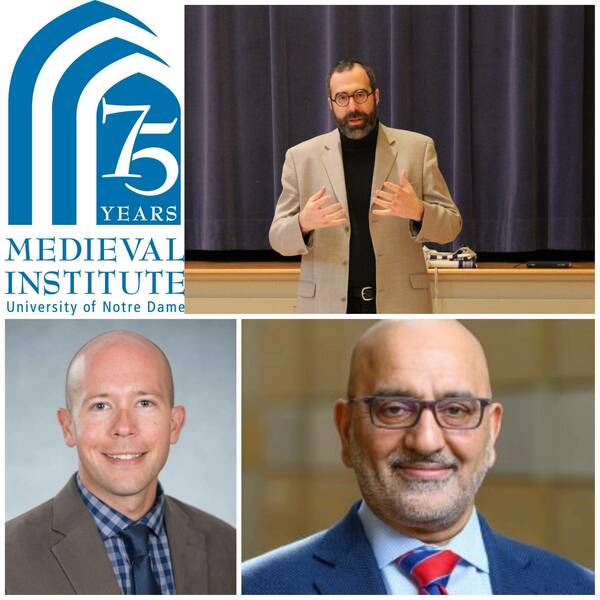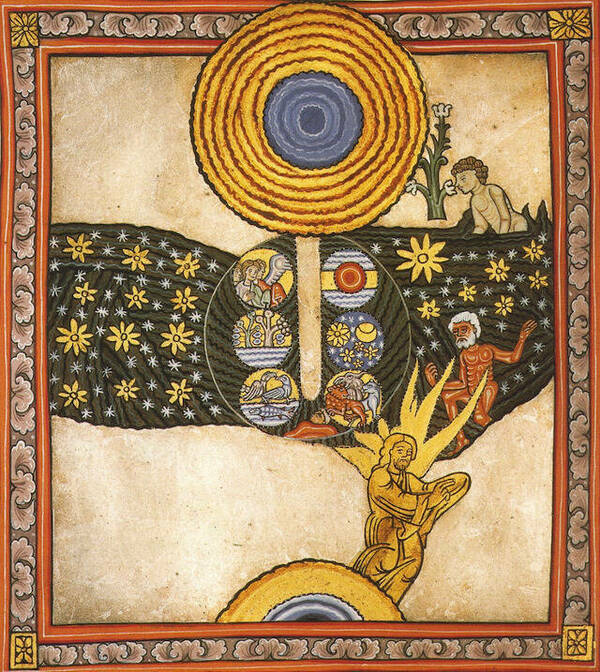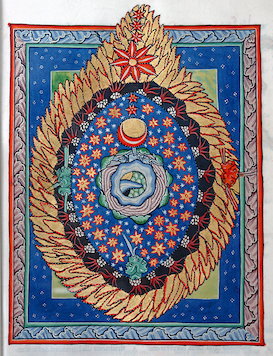The Common Good and the Creation of the Cosmos: MI Home Game Activities Provoke Discussion on Big Ideas
On Friday, November 5th and Saturday, November 6th, the Medieval Institute offered two opportunities to engage with the relevance of medieval philosophy—a roundtable on the common good in medieval texts and modern life, and a video experience of the representations of biblical creation in Hildegard's Scivias, projected on a 360 degree, 50-foot diameter dome.
On Friday afternoon, the Medieval Institute and the Ansari Institute for Global Engagement with Religion co-hosted a roundtable discussion on “The Common Good in Medieval Thought and Pandemic Debate,” facilitated by MI Faculty Fellow Therese Cory.

The three panelists, who represented three faith traditions—Michael Friedland is Rabbi at Sinai Synagogue in South Bend; Daniel Horan, in addition to his work as a professor at St. Mary's, is a Franciscan friar; and Ebrahim Moosa teaches Islamic studies at Notre Dame—each discussed a medieval writer who explored the challenges of living in a diverse society.
As the recent debates about vaccine mandates have made clear, the common good is a highly contentious topic with a variety of definitions; similar debates about religious and human freedom galvanized several medieval thinkers.
Rabbi Michael Friedland introduced the audience to Jewish historian Solomon ibn Verga (c. 1460-1554), who experienced the expulsion of Jews from Spain in 1492, writing imagined dialogues in order to emphasize the universal values underlying the Christian and Jewish faiths. Professor Daniel Horan responded to this discussion with his example, the Christian philosopher and theologian John Duns Scotus, OFM (c. 1265-1308), who rooted his thoughts on charity in the inherent dignity of individuals. Last to speak was Ebrahim Moosa on Persian scholar of Islam, Al-Ghazali (d. 1111), a polymath legal and moral philosopher who argued that humans, as God's stewards on earth, have five purposes which exist in tension: to preserve life, religion, intellect, family and property.
As the speakers concluded, to support the common good, human society must allow for individual dissent, and individuals should foster relationships across difference and self-critique their own emotion-based, irrational positions.

The next morning in the Notre Dame Digital Visualization Theater in the Jordan Hall of Science, a crowd of 70 buzzed with excitement to watch MI Faculty Fellow Margot Fassler and video artist Christian Jara's nearly-finished project "Creation and Cosmos: The Universe according to Hildegard." Since 2012, the two have been working on converting two illustrations of creation from Hildegard of Bingen's treatise Scivias, written between 1140 and 1150, into vibrant and surprising video art. (Fassler reflects on the subject in her book Cosmos, Liturgy and the Arts in the Twelfth Century: Hildegard's Illuminated Scivias, forthcoming with University of Pennsylvania Press.)
The original illuminated manuscript of Scivias was copied in 1160 and taken to safekeeping in Munich during World War II, never to be seen again; luckily, the nuns in Eibingen had made a scrupulously-detailed color copy before the war, and have shared high-resolution images with Fassler and Jara.
Using Blendr to recreate these visuals in 3D, Jara has rendered 8k by 8k images for the massive domed screen of a planetarium. He exercises discipline and a soft touch to stay as close as possible to Hildegard's vision, since he considers the medieval art "a spiritual object, a real material object that contains spirit”; likewise, the luscious score, performed by Sacred Music students, uses only Hildegard's own songs and poetry.
The nearly half-hour work itself, a stunning sequence of shifting visuals, works its way through each of the 6 days of creation in one Scivias illumination of Genesis, a period which culminates in Hildegard's famous illumination of the cosmic egg. Like Scivias itself, the presentation constantly shifts perspective from the earthly to the cosmic, showcasing not only trees sprouting and animals braying, but also Hildegard's famous depiction of the Trinity as a twisting, luminous circle.

The two collaborators are now working on their conclusion: Hildegard's spore-like cosmic egg, encased in flame, spinning in an endless dark.
This project, combining state-of-the-art technology and medieval drawings, has connected past and present. As Fassler said introducing the project, "Sometimes we feel like we reach our hands across to the nuns in the 12th century and have communion with them;" similarly, viewers left the theater feeling closer to the nuns on Eibingen and the incomprehensible beauty of the cosmos. Not your typical tailgate!
Read more about our planned events, which include medieval-themed presentations before every home game this fall.